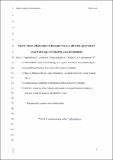Files in this item
Sperm whale echolocation behaviour reveals a directed, prior-based search strategy informed by prey distribution
Item metadata
| dc.contributor.author | Fais, A. | |
| dc.contributor.author | Aguilar de Soto, Natacha | |
| dc.contributor.author | Johnson, M. | |
| dc.contributor.author | Pérez-González, C. | |
| dc.contributor.author | Miller, P.J.O. | |
| dc.contributor.author | Madsen, P.T. | |
| dc.date.accessioned | 2016-02-07T00:12:44Z | |
| dc.date.available | 2016-02-07T00:12:44Z | |
| dc.date.issued | 2015-04 | |
| dc.identifier | 172109372 | |
| dc.identifier | 44a625e8-f490-4050-af29-238378641031 | |
| dc.identifier | 000351235100016 | |
| dc.identifier | 84925463035 | |
| dc.identifier.citation | Fais , A , Aguilar de Soto , N , Johnson , M , Pérez-González , C , Miller , P J O & Madsen , P T 2015 , ' Sperm whale echolocation behaviour reveals a directed, prior-based search strategy informed by prey distribution ' , Behavioral Ecology and Sociobiology , vol. 69 , no. 4 , pp. 663-674 . https://doi.org/10.1007/s00265-015-1877-1 | en |
| dc.identifier.issn | 0340-5443 | |
| dc.identifier.uri | https://hdl.handle.net/10023/8168 | |
| dc.description | The fieldwork was funded by a grant from the Carlsberg Foundation to B. Møhl and ONR, SERDP and FNU grants to MJ, PJOM and PTM. PJOM was supported by a Royal Society Fellowship, NAS by the International Campus of Excellence of the Canary Islands, MJ by the Marine Alliance for Science and Technology for Scotland and AF partly by project CETOBAPH (grant number CGL2009-1311218). | en |
| dc.description.abstract | Predators make foraging decisions based upon sensory information about resource availability, but little is known about how large, air-breathing predators collect and use such information to maximize energy returns when foraging in the deep sea. Here, we used archival tags to study how echolocating sperm whales (Physeter macrocephalus) use their long-range sensory capabilities to guide foraging in a deep-water habitat consisting of multiple, depth-segregated prey layers. Sperm whales employ a directed search behaviour by modulating their overall sonar sampling with the intention to exploit a particular prey layer. They forage opportunistically during some descents while actively adjusting their acoustic gaze to sequentially track different prey layers. While foraging within patches, sperm whales adjust their clicking rate both to search new water volumes as they turn and to match the prey distribution. This strategy increases information flow and suggests that sperm whales can perform auditory stream segregation of multiple targets when echolocating. Such flexibility in sampling tactics in concert with long-range sensing capabilities apparently allow sperm whales to efficiently locate and access prey resources in vast, heterogeneous, deep water habitats. | |
| dc.format.extent | 3395676 | |
| dc.language.iso | eng | |
| dc.relation.ispartof | Behavioral Ecology and Sociobiology | en |
| dc.subject | Sperm whales | en |
| dc.subject | Echolocation behaviour | en |
| dc.subject | Directed search behaviour | en |
| dc.subject | Prior information | en |
| dc.subject | Multi-target acoustic scene | en |
| dc.subject | QH301 Biology | en |
| dc.subject | QL Zoology | en |
| dc.subject | NDAS | en |
| dc.subject.lcc | QH301 | en |
| dc.subject.lcc | QL | en |
| dc.title | Sperm whale echolocation behaviour reveals a directed, prior-based search strategy informed by prey distribution | en |
| dc.type | Journal article | en |
| dc.contributor.sponsor | European Commission | en |
| dc.contributor.institution | University of St Andrews. School of Biology | en |
| dc.contributor.institution | University of St Andrews. Marine Alliance for Science & Technology Scotland | en |
| dc.contributor.institution | University of St Andrews. Sea Mammal Research Unit | en |
| dc.contributor.institution | University of St Andrews. Sound Tags Group | en |
| dc.contributor.institution | University of St Andrews. Bioacoustics group | en |
| dc.contributor.institution | University of St Andrews. Scottish Oceans Institute | en |
| dc.contributor.institution | University of St Andrews. Institute of Behavioural and Neural Sciences | en |
| dc.contributor.institution | University of St Andrews. Centre for Social Learning & Cognitive Evolution | en |
| dc.contributor.institution | University of St Andrews. Centre for Research into Ecological & Environmental Modelling | en |
| dc.identifier.doi | 10.1007/s00265-015-1877-1 | |
| dc.description.status | Peer reviewed | en |
| dc.date.embargoedUntil | 2016-02-07 | |
| dc.identifier.grantnumber | PCIG10-GA-2011-304132 | en |
This item appears in the following Collection(s)
Items in the St Andrews Research Repository are protected by copyright, with all rights reserved, unless otherwise indicated.

